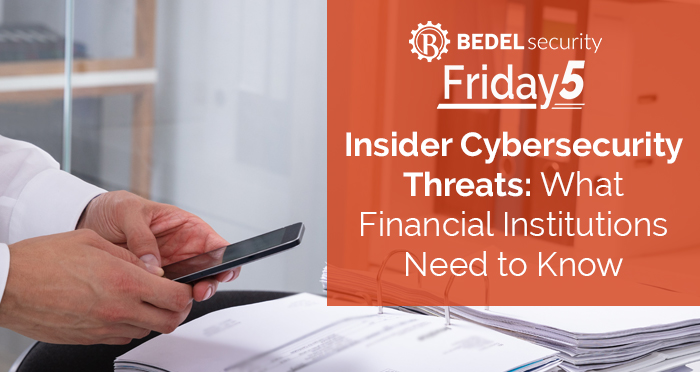2 min read
Insider Cybersecurity Threats: What Financial Institutions Need to Know
Trisha Durkin : May 19, 2023


Community financial institutions face a wide range of cybersecurity threats, but one of the most concerning is insider threats. Insider threats refer to employees or contractors who intentionally or unintentionally compromise a financial institution's security. These threats can be difficult to detect and prevent, and they can cause significant damage to a financial institution's reputation and financial stability. Let’s take a closer look at insider cybersecurity threats affecting financial institutions and what they can do to protect themselves.
Types of Insider Cybersecurity Threats
Insider threats can take many forms, and it's important for community financial institutions to understand the different types of threats they may face. Here are a few examples:
Malicious insiders: Malicious insiders are employees or contractors who intentionally compromise a financial institution's security. They may steal customer data, share login credentials, or introduce malware into the system. Malicious insiders can be difficult to detect because they often have legitimate access to systems.
Careless insiders: Careless insiders are employees or contractors who unintentionally compromise a financial institution's security. They may click on a phishing email or leave their computer unlocked, allowing someone else to access sensitive data. Careless insiders can be just as damaging as malicious insiders, but their actions are usually unintentional.
Third-party insiders: Third-party insiders are contractors or vendors who have access to our systems. They may inadvertently introduce malware or steal sensitive data. Third-party insiders can be particularly challenging to manage because they are not employees of the institution.
Preventing Insider Cybersecurity Threats
So how do we go about preventing insider cybersecurity threats? The best way is a multifaceted approach that involves technology, policies, and training. Here are a few steps we can take:
Implement access controls: Access controls are a critical component of any cybersecurity strategy. Financial institutions should limit access to sensitive data and systems to only those employees who need it to perform their job duties. Access should be reviewed regularly and revoked when it is no longer necessary.
Monitor employee activity: Financial institutions should monitor employee activity to detect potential insider threats. This can include monitoring network activity, email logs, and file access logs. Monitoring should be done in a way that respects employee privacy, but it should be comprehensive enough to detect potential threats.
Conduct regular security training: Regular security training can help employees understand the importance of cybersecurity and how to avoid potential threats. Training should cover topics such as phishing scams, password management, and data protection. It should also include specific examples of insider threats and how to prevent them.
Review third-party contracts: Financial institutions should review their contracts with third-party vendors and contractors to ensure they are following proper cybersecurity protocols. Contracts should include provisions for cybersecurity and data protection.
Respond quickly to incidents: Financial institutions should have a plan in place for responding to cybersecurity incidents, including insider threats. The plan should include steps for identifying the source of the threat, containing the damage, and communicating with customers and regulators.
Insider cybersecurity threats are a serious concern for financial institutions. By implementing access controls, monitoring employee activity, conducting regular security training, reviewing third-party contracts, and responding quickly to incidents, financial institutions can protect themselves against these threats.
Bedel Security exclusively helps financial institutions develop and improve their cybersecurity program and would be happy to chat about how we can help your program. Send us an email at support@bedelsecurity.com to start a conversation.

Rising Insider Threats: Causes and Countermeasures
Insider threats are becoming an increasingly serious issue for financial institutions, often developing quietly but with potentially severe...

Russian Cyberthreats
This week the threat from Russia to the Ukraine has turned to reality. The attack was preceded by cyber threats probably long before the physical...
